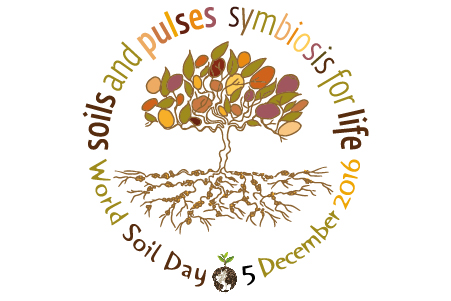Soils
Soil is an essential resource and a vital part of the natural environment from which most of the global food is produced. At the same time, soil provides living space for humans, as well as essential ecosystem services which are important for water regulation and supply, climate regulation, biodiversity conservation, carbon sequestration and cultural services.
It is difficult to rate the importance of the different soil functions, since all are vital to our well-being to some extent. However, the function of supporting food and agriculture worldwide is fundamental for the preservation and advancement of human life on this planet. Soil is also the basis for plant growth and contributes to the maintenance of natural and planted vegetation, including our diverse forests and grasslands and the huge breadth of crop species and varieties that are cultivated or managed for their diverse food, fiber, fodder, fuel and medicinal products in relation to the prevailing climate, landscape and soil type and according to societal needs.
Through plant growth, the soil also plays an important role in supporting animal biodiversity above ground, including wildlife and domesticated livestock. Moreover, the soil itself contains millions of diverse organisms that perform many vital functions such as the breakdown of plant debris, assimilating components from the atmosphere, aerating the soil, as well as regulation of carbon, nutrient and hydrological cycles and breakdown of toxic elements. Soil is increasingly recognized as playing a fundamental role in the quality and availability of our water supply. The soil, coupled with the landscape and its vegetation, is responsible for the distribution of all rainwater falling upon it and thus plays a key role with respect to the water cycle and supply as now recognised by hydrologists. Related to how water moves through the soil and the absorption properties of soils is the soil's ability to perform an important function in pollution control (pesticides, nitrates etc.). Soil has always been important for the foundation platform of buildings, roads and other constructions, while also providing base materials for these.
Finally, soils have been recognized as having a key role in modifying and ameliorating the risks and effects of climate change by regulating dynamic biochemical processes and the exchange of greenhouse gases (GHG) with the atmosphere. Soil organic matter is one of the major pools of carbon in the biosphere and is important both as a driver of climatic change and as a response variable to climate change capable of acting both as a source and sink of carbon. Sustainable and climate-resilient soil management plays an essential part in the climate system and in the terrestrial carbon balance.
The Global Symposium on Soil Organic Carbon that will take place from 21 to 23 March 2017 at the FAO headquarters will focus on the role of soils and soil organic carbon (SOC) in the climate system. This high-level international scientific meeting organized by the GSP/ITPS with FAO support will enable and strengthen the provision of knowledge on SOC measurement, modeling and management while identifying promising research, policies, and action plans for maximizing the potential of soil carbon sequestration for climate change adaptation/ mitigation.
The Global Soil Partnership
The Global Soil Partnership was established in December 2012 as a mechanism to develop a strong interactive partnership and enhanced collaboration and synergy of efforts between all stakeholders. From land users through to policy makers, one of the key objectives of the GSP is to improve the governance and promote sustainable management of soils. Since its creation, the GSP has become an important partnership where global soil issues are discussed and addressed by multiple stakeholders. Key outputs demonstrate that the partnership was needed to fill an existing gap in the promotion of sustainable soil management.
Regional Soil Partnerships (RSPs) were established among interested and active stakeholders of the same regions. These RSPs are working in close collaboration with FAO Regional Offices and establishing an interactive consultative process with national soil entities (soil survey institutions, soil management institutions, soil research institutions and soil scientists working in land resources, climate change and biodiversity institutions/programmes, etc), as well as with regional soil science societies and other relevant regional mechanisms under the various related conventions.
In order to achieve its mandate, the GSP addresses five pillars of action to be implemented in collaboration with its regional soil partnerships :

The Intergovernmental Technical Panel on Soils (ITPS) was established at the first Plenary Assembly of the Global Soil Partnership held at FAO Headquarters on 11 and 12 of June, 2013. The ITPS is composed of 27 top soil experts representing all the regions of the world. The main function of the ITPS is to provide scientific and technical advice and guidance on global soil issues to the Global Soil Partnership primarily and to specific requests submitted by global or regional institutions. Among the key outputs of the ITPS, it is worth mentioning the Voluntary Guidelines for Sustainable Soil Management, recently endorsed by the 155th session of the FAO Council, Status of the World's Soil Resources and the Revised World Soil Charter.
International Year of Soils 2015

The International Year of Soils 2015 has been an exciting year packed with soil-themed initiatives that have taken place across the globe. Calling soils "a nearly forgotten resource", the FAO Director General Graziano da Silva called for more investment in sustainable soil management and awareness raising activities. Giving this silent ally a voice became one of the main goals of the IYS global campaign.
Thanks to a 12 months campaign, the key role of soils in our sustainable future has become evident and a vast amount of information material has been produced in numerous languages. The IYS information packet makes the topic of soils accessible to everyone and includes fact sheets, infographics, educational booklets, videos, posters, interviews and stories. Also, for the first time soils have been explicitly mentioned in 4 targets of the 17 Sustainable Development Goals (SDGs) and strong foundations are in place for more happen.
Awareness raising continues with World Soil Day, a special day to spread the voice on how important healthy soils are for a healthy life, to be celebrated every 5th December and the Glinka World Soil Prize, established under the GSP aegis. On the occasion of WSD 2016 the Glinka Prize was awarded for the first time to the Colombian Instituto Geografico Agustin Codazzi (IGAC) in recognition of its leadership and activities contributing to the promotion of sustainable soil management.
World Soil Day

The World Soil Day campaign aims to connect people with soils and raise awareness on their critical importance in our lives. Under the leadership of the Kingdom of Thailand and within the framework of the Global Soil Partnership, FAO has supported the formal establishment of the World Soil Day as a global awareness raising platform. The FAO Conference, in June 2013, unanimously endorsed World Soil Day and requested official adoption at the 68th UN General Assembly. In December 2013, the 68th UN General Assembly declared 5th of December as the World Soil Day.
Since 2012, the FAO-GSP has been organizing celebration events of this important day.
WSD 2016 celebrations officially kicked off at the UN Headquarters in New York with the book launch `Soils and Pulses, symbiosis for life', and continued with side events at FAO Headquarters in Rome, FAO regional offices, at the Convention on Biological diversity COP13 in Cancun, Mexico and worldwide through many national, regional and local events. The 2016 theme “Soils and pulses, a symbiosis for life” emphasized the synergies between soils and pulses, their important contribution to increase soil fertility, biodiversity and land productivity (SDG 2 and SDG 15), and their major role in addressing future global food security, and environmental challenges.








